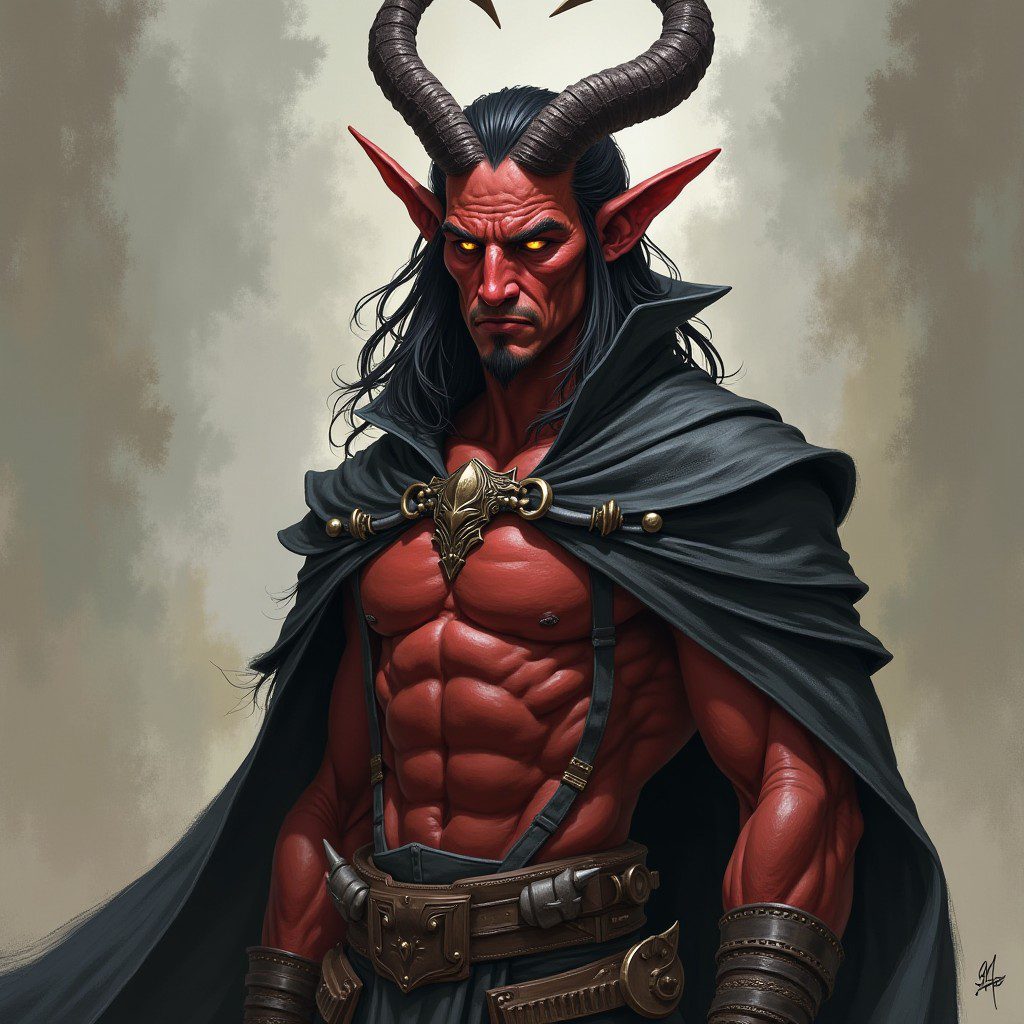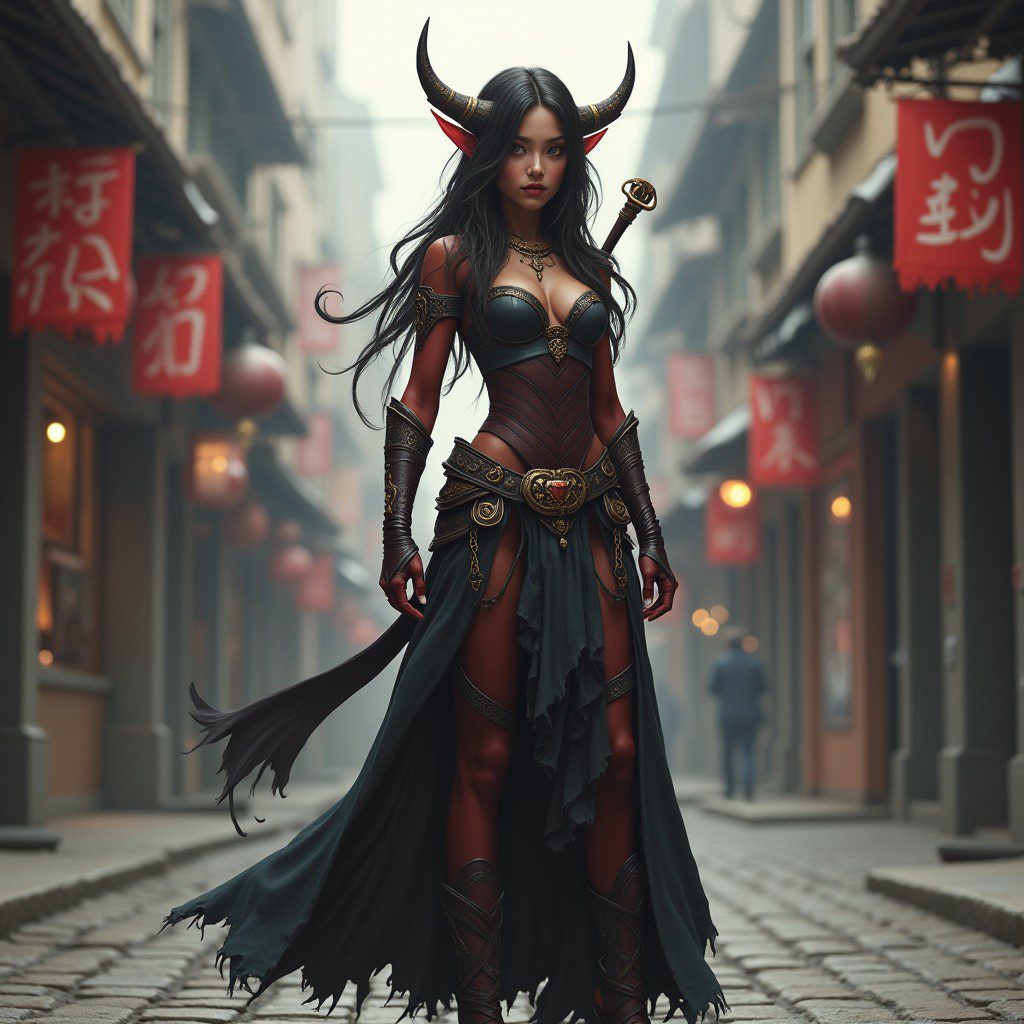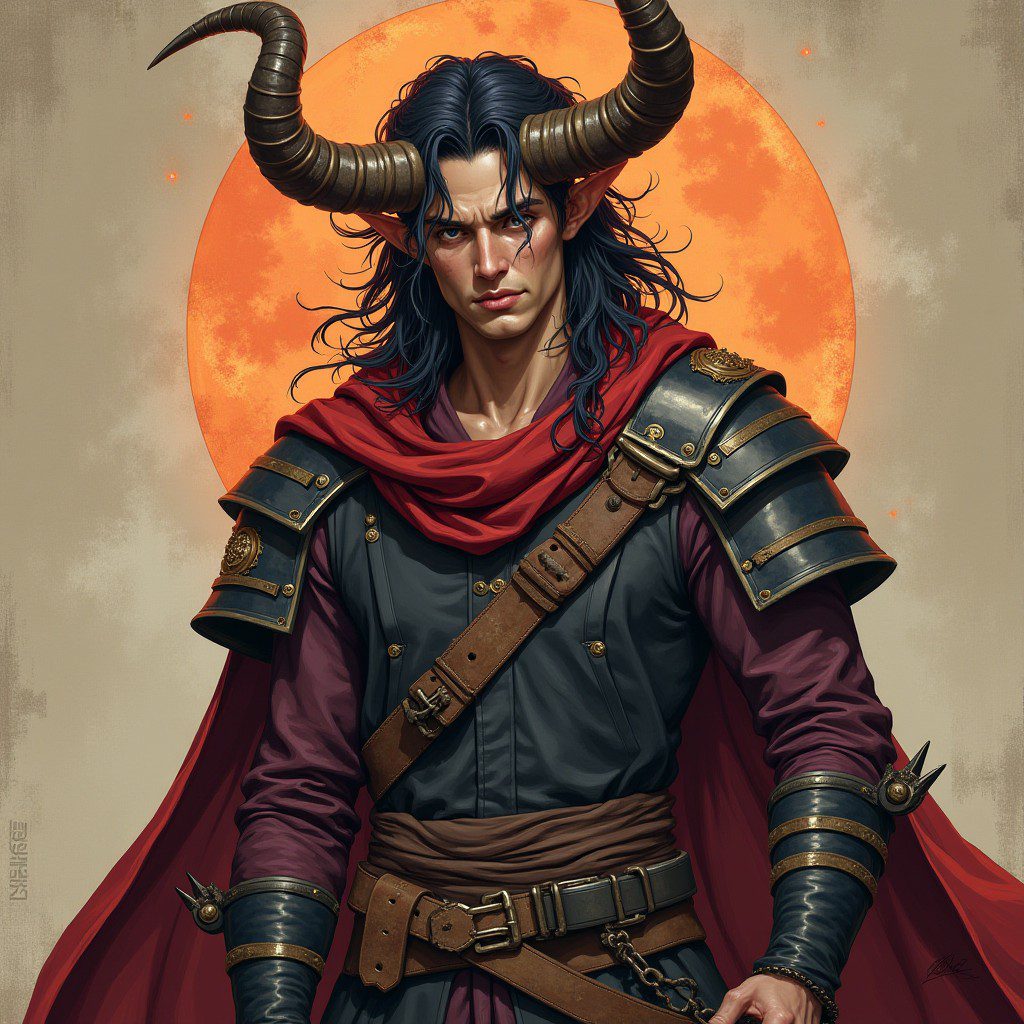Tiefling: The Fiendish Outcasts of Fantasy

Tieflings are one of the most iconic races in modern fantasy, especially within the Dungeons & Dragons (D&D) universe. Known for their infernal heritage, they are humanoids with demonic or devilish ancestry. This dark lineage manifests in their appearance, giving them fiendish traits such as horns, tails, and glowing eyes. Tieflings often face prejudice and mistrust from other races due to their connection to the Nine Hells or other infernal planes, but they are complex characters who struggle between the weight of their heritage and their desire to define their own destiny.
While Tieflings are most famously associated with D&D, they appear in a variety of fantasy settings, often as characters who must navigate a world that fears or misunderstands them.
Origins of Tieflings in Dungeons & Dragons
Tieflings were first introduced in Dungeons & Dragons during the Planescape campaign setting in the early 1990s, where they were depicted as the offspring of humans and fiends—typically devils or demons. Over time, their depiction has evolved, and in later editions, particularly D&D 5th Edition, their infernal heritage is often tied to Asmodeus, the ruler of the Nine Hells, though Tieflings can have other fiendish ancestry as well.
Tieflings are not born from direct unions between fiends and mortals but are instead descendants of such pairings, or sometimes they carry a curse or pact that causes infernal traits to manifest in their bloodline. This means that Tieflings can appear in human families without warning, marking them as different from birth.
Physical Appearance


Tieflings are often described as humanoid, but with distinct fiendish characteristics. Their appearance varies, but common traits include:
- Horns: Tieflings have horns that can range from small nubs to large, curling horns like those of a ram or a bull.
- Tails: Most Tieflings have a long, prehensile tail that is often around 4 to 5 feet in length.
- Unnatural Skin Colors: Tiefling skin tones often reflect their infernal origins, with colors like red, purple, or even blue. In some cases, they may have more human-like complexions, but with a slight tint or glow.
- Eyes and Teeth: Tiefling eyes are typically solid colors, lacking pupils, and may glow faintly. Their teeth are often sharp, resembling those of a predator.
Though their fiendish appearance often makes them stand out, Tieflings are not inherently evil. Their physical traits are simply a manifestation of their ancestry, and their moral alignment can be as varied as that of humans or any other race.
The Infernal Heritage of Tieflings
In Dungeons & Dragons, Tieflings are often linked to Asmodeus, the powerful archdevil who rules the Nine Hells. Asmodeus is a cunning and manipulative being, and many Tieflings carry his bloodline due to ancient pacts or curses made by their ancestors. These pacts may have been made in exchange for power, wealth, or protection, but they often come at a steep cost: the permanent mark of infernal influence on future generations.
However, not all Tieflings are tied to Asmodeus. Some may descend from other powerful fiends, including demons, yugoloths, or other devilish figures. This can influence their physical traits and personalities. For instance, a Tiefling with demonic ancestry may have a more chaotic or destructive nature, while those descended from devils may be more calculating and manipulative.
Despite this fiendish connection, Tieflings are not bound by their heritage. Many struggle with their infernal ancestry and the prejudices they face because of it, striving to carve out their own path in a world that often views them with suspicion or fear.
Tiefling Abilities in Dungeons & Dragons
In D&D, Tieflings are defined not only by their appearance but also by their unique abilities, which reflect their infernal heritage. These abilities give them an edge in dangerous situations and set them apart from other humanoid races.
1. Infernal Legacy
One of the most notable traits of Tieflings is their connection to magic. They possess the Infernal Legacy, which grants them access to innate magical abilities, including:
- Thaumaturgy: At 1st level, Tieflings can cast this cantrip, which allows them to create harmless but dramatic effects such as booming voices, shaking ground, or changing the appearance of their eyes. This ability emphasizes their connection to infernal powers and can be used to intimidate or impress others.
- Hellish Rebuke: At 3rd level, Tieflings gain the ability to cast this spell, which allows them to retaliate when they are harmed by engulfing their attacker in flames. This ability reflects the fiery, vengeful nature of their ancestry.
- Darkness: At 5th level, Tieflings can cast Darkness, creating an area of magical darkness that even darkvision cannot penetrate. This spell enhances their stealth and ability to control the battlefield.
2. Fire Resistance
Due to their infernal bloodline, Tieflings are naturally resistant to fire damage. This is a reflection of their heritage, as many fiends are beings of fire and brimstone. This ability makes Tieflings formidable in environments where fire and heat pose significant dangers.
3. Charisma
Tieflings often have a high Charisma score, which reflects their strong personalities, whether that manifests as charm, intimidation, or manipulation. Despite the mistrust they may face, Tieflings are often charismatic and can sway others through sheer force of will.
Culture and Society
Tieflings are often depicted as outsiders in most fantasy settings, and their infernal heritage means they frequently face prejudice and fear. Many societies in fantasy worlds view Tieflings with suspicion, associating them with evil forces and dangerous pacts, even if the individual Tiefling has done nothing wrong. As a result, Tieflings often grow up on the fringes of society or in slums, struggling to find acceptance.
This constant struggle with prejudice shapes Tiefling culture, often instilling a strong sense of independence and self-reliance in them. Some Tieflings lean into the negative stereotypes, using their fearsome appearance to intimidate others, while others seek to rise above their ancestry, proving through their actions that they are not bound by their infernal blood.
In some settings, Tieflings may form their own communities, where they can live without the constant fear of discrimination. These communities are often tight-knit, with a focus on mutual support and resilience in the face of adversity.
Alignment and Morality
Despite their infernal heritage, Tieflings are not inherently evil. In fact, their alignment and moral compass can be as varied as any other race. Some Tieflings embrace the darkness within them, becoming rogues, warlocks, or dark sorcerers, while others seek to reject their heritage, becoming paladins, clerics, or champions of justice.
The choice between good and evil is often a central theme in the stories of Tiefling characters. Many Tieflings are haunted by the legacy of their ancestors, striving to break free from the dark pacts that shaped their bloodline. Others, however, may feel a pull toward the infernal powers that run through their veins, using their abilities to gain power or control over others.
Ultimately, Tieflings are defined not by their ancestry but by the choices they make. This internal struggle between their fiendish heritage and their personal values makes Tieflings some of the most complex and compelling characters in fantasy.
Tieflings in Modern Media
While Tieflings are most associated with Dungeons & Dragons, their archetype—of a character torn between their dark heritage and their desire to forge their own path—appears in various forms in modern fantasy.
1. Literature
Tieflings and similar fiendish characters appear in many fantasy novels, particularly in series inspired by D&D. These characters often grapple with the duality of their nature and the societal rejection they face due to their appearance. The themes of prejudice, redemption, and self-determination are common in their narratives.
2. Video Games
In video games like Baldur’s Gate III and Neverwinter Nights, both of which are based on the Dungeons & Dragons universe, Tieflings are often playable races. Their unique abilities and moral complexity make them popular choices for players who enjoy rich character development and diverse playstyles.
3. Films and Television
While Tieflings have not been as prominently featured in films or TV shows as other fantasy races like elves or dwarves, the concept of characters struggling with infernal ancestry has appeared in series like The Witcher and Supernatural, where individuals with demonic or fiendish heritage grapple with their identity and powers.
Strengths and Weaknesses of Tieflings
Strengths:
- Innate Magic: Tieflings’ connection to infernal magic gives them access to powerful abilities, such as casting spells like Hellish Rebuke and Darkness, which can turn the tide in combat or intimidate enemies.
- Fire Resistance: Tieflings’ natural resistance to fire damage makes them incredibly resilient in situations involving fire or heat, a common element in many fantasy battles.
- Strong Personalities: Tieflings are often highly charismatic, making them natural leaders, diplomats, or manipulators. Their strong personalities help them navigate a world that often fears or misunderstands them.
Weaknesses:
- Prejudice and Mistrust: Tieflings often face intense prejudice from other races due to their infernal appearance and heritage. This mistrust can make it difficult for them to form alliances or gain acceptance in many societies.
- Struggle with Identity: Many Tieflings grapple with their infernal bloodline and the legacy of their ancestors. This internal conflict can lead to feelings of isolation, guilt, or anger, particularly if they are judged solely based on their appearance.
- Marked by Fiendish Heritage: Tieflings’ devilish or demonic traits are visible to all, making it difficult for them to blend in or hide their ancestry. Their horns, tails, and glowing eyes make them stand out, even if they try to live a normal life.
The Legacy of Tieflings: Complex and Powerful
Tieflings are one of the most complex and intriguing races in fantasy, embodying the tension between good and evil, freedom and fate. Their infernal heritage makes them both powerful and feared, but it is their personal struggles, their ability to rise above prejudice, and their quest for self-identity that make them truly fascinating characters.
Whether they embrace their dark lineage or strive to overcome it, Tieflings are defined not by the blood that flows through their veins, but by the choices they make. This constant tension between destiny and free will ensures that Tieflings will remain a beloved and enduring part of the fantasy genre for years to come.
